Keep it simple. Three words that are hard to put into practice when it comes to suckling. The basics of suckler farming are relatively straightforward: get the cow in calf, get the calf born safely and produce a good quality animal with plenty of liveweight. It takes a good farmer to be able to keep the system simple and deliver on these objectives.
It is the management decisions that make a suckler system complicated. The reason things can become complicated is because there is no defined system in place.
Changing back and forth between finishing cattle and selling live because of market prices, will mean there is no set routine to work towards. It also plays havoc with cashflow on-farm.
Prolonged calving patterns mean that cows are at various stages of lactation as well as being dried off, which makes it difficult to match feed requirements to cows and, often, it leads to multiple groups of cattle.
These scenarios are common on Irish suckler farms. Normally, routine management tasks are completed adequately, but not always effectively or on time. For example, on such farms, there will be calves that have missed dehorning or a worm dose is not carried out in time to give effective cover ahead of a high-risk period.
There is no doubt that keeping things simple is a massive help to running a well-managed suckler herd. When things are kept simple, the herdowner has time to attend to all tasks and give them full attention. It also makes it easier to pick up on any animal health problems at an early stage.
In Galway, Michael O’Donohoe runs a spring-calving suckler herd of 60 cows. He farms along with his father, Michael Sr, taking all cattle born on-farm through to beef on their 210-acre grassland farm near Abbeyknockmoy.
Simplicity is at the very core of the management on-farm. Replacements are purchased annually as in-calf heifers coming close to calving, which limits the number of stock groups on-farm to manage. With no homebred heifers retained on-farm, Michael can focus on using terminal sires to maximise liveweight gain and carcase weight of finishing cattle.
Farm background
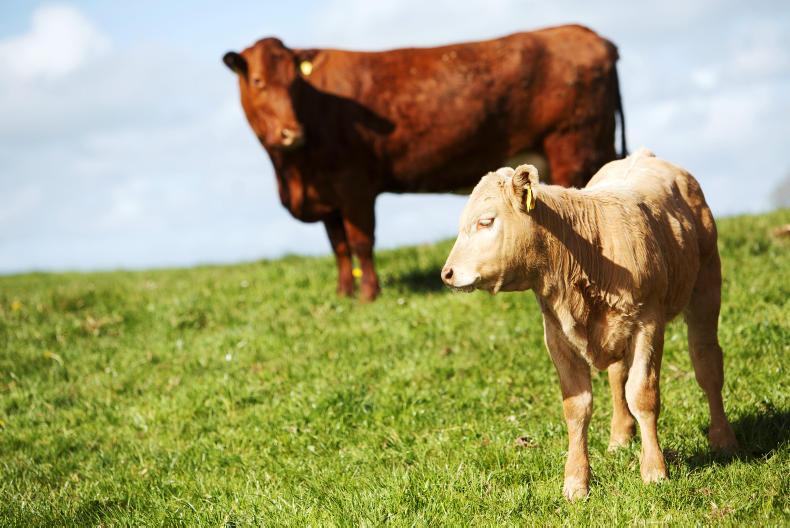
The farm is well laid out for a suckler farm, with 150 acres in one block adjacent to the main farmyard. The remaining land is split over three smaller blocks, but in relatively close proximity to the yard. Land is typical of the area, with well laid out grazing fields and dry, limestone soils allowing for early turnout of stock. The suckler herd is long established and cattle are taken through to finish at 24 months of age for both steers and heifers.
The breeding herd has two very distinct cow types. Approximately half the cows are three-quarter-bred Limousin, with several cows moving towards purebred. The other half of the herd are three-quarter-bred Simmental cross cows that still have a bit of Friesian present.
Why the two cow types? The red Limousin cow and Charolais bull breed a consistent calf type – the orange Charolais – whereas there is a mix of calf type with the Simmental cross.
“It is getting harder to source the three-quarter-bred Limousin animal that will have plenty of milk. When they do come onto the market they are expensive. The Simmental cross is a great mother also and will normally be carrying milk.”
Replacements
Replacements have always been bought in.
“Breeding my own heifers means I have an extra group of cattle to graze and rear. I would have to be using a maternal bull on 15 to 20 cows to get enough suitable heifers born each year.
‘‘That means I would have to swap one of my Charolais bulls for a different breed of stock bull, as it wouldn’t be feasible to run three stock bulls and my Charolais bulls are not maternal. After that, I would need to be using AI on maiden heifers as there would only be six or seven animals to breed every year.
‘‘Using AI would mean having to bring heifers in and out for serving and watching for heats. These animals would also need to be kept beside the yard.
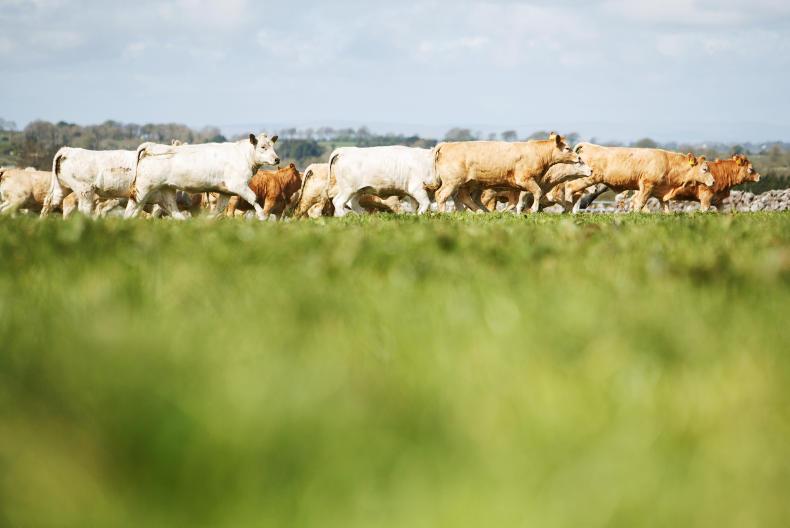
‘‘I like the simplicity of my system. For me, it is much easier to buy in-calf heifers over the winter and then just run two groups of 30 cows and calves over the grazing season. Having a simple routine means the focus is on weight gain.”
According to Michael, the other advantage of buying in-calf heifers is that he can source well-developed heifers that will be strong enough to rear a calf and come back breeding again. Heifers are usually purchased at a special breeding sale or from a herd reduction/dispersal sale.
“I don’t like buying heifers as single lots in the marts. You could be buying in trouble and not know it until it is too late. It is also too time-consuming buying single lots.
‘‘I prefer to go to a special sale because you are more likely to buy three or four animals from a herd that is genuine. It’s the same with a dispersal sale, the animals will be sold for a good reason and you can see the quality of the rest of the cattle in the herd.
‘‘This way, you stand a better chance of buying good heifers rather than taking the chance on single lots in the mart.”
Occasionally, Michael will opt to buy a calved heifer with calf at foot, if it fits in with his cow type and breeding pattern.
Cow selection
As heifers are purchased in late pregnancy or as they come springing, the age of the animal at first calving is less important in Michael’s system. With a good beef cow, the cull value helps to cover most of the purchase cost – with in-calf heifers trading around €1,500.
“I want a cow that has plenty of width, especially in the hindquarters, because I would be using good, strong Charolais bulls. A good width across the pelvis will help with calving ease. Heifers also need to be square and have plenty of length to get carcase weight for finishing cattle. Good feet and legs are important as I want mobile cows that will last.”
Limousin cows often get a bad reputation when it comes to temperament, but there are few such issues in the herd. Cows are very quiet and when walking through them, quality and cow type is good and very consistent.
Limousin cows are mainly R-grade with a few U-grading animals. Yet, they have plenty of milk and still hold body condition. Udders are well developed and tight, with good teat placement, which helps when getting calves on to suckling shortly after calving.
Simmental cows are also good, functional, R-grade cows with some dairy breeding in their background. There is an occasional cow with a pendulous udder or bottled teats, which is more common as cows of this type get older.
“Milk is important to drive weaning weight. I want milky cows to rear heavy calves as there is no creep feeders used on-farm. Calves do not get meal until weaning time.”
Cow longevity is good in the herd. Cows usually breed up until 10 years of age before culling. This helps to depreciate the cost of a replacement heifer and keep replacement rate down at 10%.
Bull selection
Stock bulls have always been Charolais.
“I think that the Charolais is still hard to beat when it comes to producing finishing cattle. They have weight and shape, which is what pays.”
Bulls are selected purely on terminal traits, with five-star animals purchased. Visual quality of the animal is the number one selection priority. When it comes to calving ease, Michael relies on his experience of working with the breed, as well as using figures. While bulls are muscular with plenty of power, they are not extreme, heavily-boned animals.
How the cow is fed plays a big part in calving ease. There are plenty of cows that are served with bulls that have easy calving, but still need regular assistance during labour. The problem is down to cows having too much condition and laying down fat in the birth canal.
Cows that are underfed can also have difficulty at calving. Even just a lack of exercise from housing cows for four to five months before calving can make cows lazy during labour, with weak contractions which slow the calf delivery.
In a lot of cases, the cause of the calving difficulty is placed on the bull rather than the farmer taking responsibility for their management which is wrong, because if fed the same way the following year, the same calving difficulties can continue to be a problem.
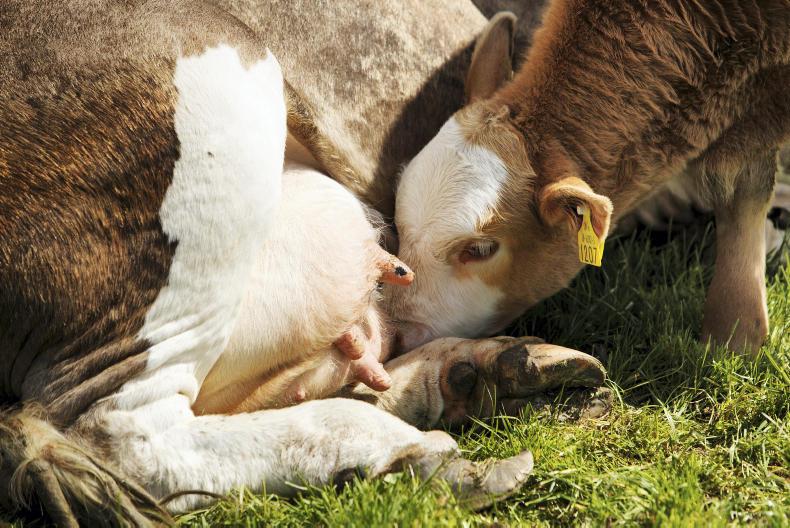
“Most of the cows calve on their own. We would only have to handle a few cows at calving and rarely need the vet. I put a lot of this down to having good square-framed cows that calve down in good condition.
“We wean the cows in early autumn. Early weaning allows calves to graze late in the autumn on good grass and it gives the cow time to gain condition at grass before housing. Once housed, they are fed first-cut silage to maintain body condition at a score of 3.0 to 3.5 up until calving. The Simmental cross cows need to be coming into the house fleshed as they are harder to bring up in condition when indoors, especially as they get older.
“Silage quality is always good (70+ DMD) because we have finishing cattle on the farm which helps. As cows get closer to calving, the amount of silage offered in increased. Minerals is something else that helps to cut down on calving problems. We feed plenty of minerals, which is a big help to get calves up and suckling quickly. Minerals are offered through a bolus at housing and then powdered minerals dusted on top of silage. We had a few dwarf calves in the past, which is why we use the bolus”.
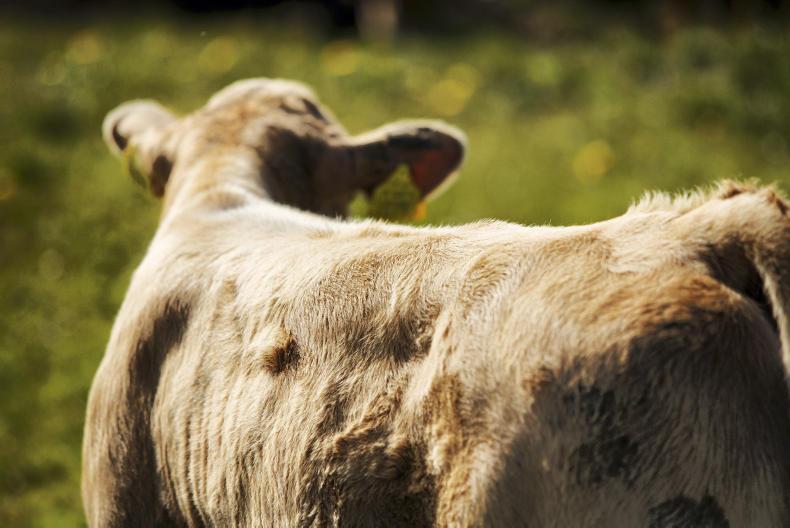
Breeding
To keep the system simple, all cows are spring-calving in February and March, with a calving interval close to 370 days. Calving in early spring suits the land type, as freshly-calved cows can slip out to grass as weather permits.
The early turnout to grass helps to prevent disease and mastitis problems in the more milky cows that would be housed after calving. It is also a massive labour saver.
Stock bulls are put out to the cows from mid-April. Although the stock bulls are both mature animals, one is older than the other at five and seven years old, respectively.
“The different age of bulls is so that when we cull a bull, we still have one mature animal and a young bull. Young bulls need plenty of management and if he wasn’t fit for a big group, a mature bull could cover the extra cows.”
Cows are split in two groups of 30, depending on whether they are Limousin or Simmental. Stock bulls stay with the cows until late June. Cows are then scanned and empty cows fattened. Stock bulls are not rotated to safeguard against sub-fertility. Instead, Michael monitors cow repeats to pick up any problems with breeding. And they do occur. Two years ago, a bull went lame early in the season.
Michael acted swiftly to remove the animal and replace him with a new stock bull. The quick decision proved to be an invaluable one, as calving pattern was held reasonably tight with only a few cows slipping. These cows have since made up the time again.
Finishing
As well as finishing all calves born on-farm, he buys in around 50 bull weanlings every autumn, weighing 350kg to 400kg, to match his own male calves. Purchase price has been rising.
It works well because the extra finishing numbers give me a bit more power to negotiate on price
Weanlings in autumn 2014 were bought for between €700 and €800, whereas last autumn the same animal type was bought for closer to €900. These animals are castrated and taken through to slaughter the following winter at 24 months.
“It works well because the extra finishing numbers give me a bit more power to negotiate on price. I sell all the steers together rather than constantly drafting cattle weekly in smaller lots.”
Running homebred steers and a group of bought-in steers over the summer before finishing in winter allows for a comparison of weights.
“My own cattle are always heavier in terms of carcase weight, despite cattle being fairly similar in size. Bought-in steers are good Charolais-cross and Limousin-cross animals.
‘‘The average carcase weight for my own cattle was 416kg. The bought-in cattle weighed 385kg on average. The difference in weight at €4/kg is €120. The homebred heifers killed on average 350kg carcase weight. Cattle will consume 750kg of concentrate during a 100- to 120-day feeding period.’’
“I think things are working well in the system and I do not see much change, other than trying to improve what I am already doing. The only thing that may become an issue is weight limits on steers. At present, we are okay on limit. But a lighter carcase weight limit may require feeding the steer earlier for finishing to get the correct cover on them,” Michael says.
And who could blame him. He is sticking to his strengths, which are clearly working on-farm. I did pose a few different options for the farm, but Michael is clearly confident in his current system. Other options for the farm included:
Bull beef
“Not for me. I have thought about bulls and there are plenty of farms in the area killing them. But I think the steer system works well here. With the bull you will get extra carcase weight, but they require a very high level of management from day one to get them all finished properly. Also, when beef supplies are strong, the processors usually discount the bull first. I think with the steer I have greater flexibility and more options.’’
Changing stock: bull breed
“We have always been Charolais and I’m more than happy with the cattle they produce. I get good weight gain from a grass-based system. Cows are not meal-fed nor calves creep-fed. Cattle do not really see meal until the finishing period yet still kill-out well.”
Killing heifers off grass
“There are a few heifers that would kill off grass in autumn. But they would kill at a lower carcase weight than they currently do in December. Feeding meal at grass can be tricky and our ground would be soft in autumn, so there would be a lot of damage to swards. In late autumn, heifers would need 5kg to 6kg of meal every day. I think it is easier to bring them in and feed them well for a couple of months and save the ground for early turnout.”
Homebred replacements
“As long as I can continue to source the type of cow I’m working with, I think I will stick at the current system as it is working well, and I will just focus on the finishing end of things. I only need half a dozen heifers each year for replacements, so I think it makes more sense to purchase these animals rather than breed my own.”
Read more
Switching from continental to traditional beef breeds
Keep it simple. Three words that are hard to put into practice when it comes to suckling. The basics of suckler farming are relatively straightforward: get the cow in calf, get the calf born safely and produce a good quality animal with plenty of liveweight. It takes a good farmer to be able to keep the system simple and deliver on these objectives.
It is the management decisions that make a suckler system complicated. The reason things can become complicated is because there is no defined system in place.
Changing back and forth between finishing cattle and selling live because of market prices, will mean there is no set routine to work towards. It also plays havoc with cashflow on-farm.
Prolonged calving patterns mean that cows are at various stages of lactation as well as being dried off, which makes it difficult to match feed requirements to cows and, often, it leads to multiple groups of cattle.
These scenarios are common on Irish suckler farms. Normally, routine management tasks are completed adequately, but not always effectively or on time. For example, on such farms, there will be calves that have missed dehorning or a worm dose is not carried out in time to give effective cover ahead of a high-risk period.
There is no doubt that keeping things simple is a massive help to running a well-managed suckler herd. When things are kept simple, the herdowner has time to attend to all tasks and give them full attention. It also makes it easier to pick up on any animal health problems at an early stage.
In Galway, Michael O’Donohoe runs a spring-calving suckler herd of 60 cows. He farms along with his father, Michael Sr, taking all cattle born on-farm through to beef on their 210-acre grassland farm near Abbeyknockmoy.
Simplicity is at the very core of the management on-farm. Replacements are purchased annually as in-calf heifers coming close to calving, which limits the number of stock groups on-farm to manage. With no homebred heifers retained on-farm, Michael can focus on using terminal sires to maximise liveweight gain and carcase weight of finishing cattle.
Farm background

The farm is well laid out for a suckler farm, with 150 acres in one block adjacent to the main farmyard. The remaining land is split over three smaller blocks, but in relatively close proximity to the yard. Land is typical of the area, with well laid out grazing fields and dry, limestone soils allowing for early turnout of stock. The suckler herd is long established and cattle are taken through to finish at 24 months of age for both steers and heifers.
The breeding herd has two very distinct cow types. Approximately half the cows are three-quarter-bred Limousin, with several cows moving towards purebred. The other half of the herd are three-quarter-bred Simmental cross cows that still have a bit of Friesian present.
Why the two cow types? The red Limousin cow and Charolais bull breed a consistent calf type – the orange Charolais – whereas there is a mix of calf type with the Simmental cross.
“It is getting harder to source the three-quarter-bred Limousin animal that will have plenty of milk. When they do come onto the market they are expensive. The Simmental cross is a great mother also and will normally be carrying milk.”
Replacements
Replacements have always been bought in.
“Breeding my own heifers means I have an extra group of cattle to graze and rear. I would have to be using a maternal bull on 15 to 20 cows to get enough suitable heifers born each year.
‘‘That means I would have to swap one of my Charolais bulls for a different breed of stock bull, as it wouldn’t be feasible to run three stock bulls and my Charolais bulls are not maternal. After that, I would need to be using AI on maiden heifers as there would only be six or seven animals to breed every year.
‘‘Using AI would mean having to bring heifers in and out for serving and watching for heats. These animals would also need to be kept beside the yard.

‘‘I like the simplicity of my system. For me, it is much easier to buy in-calf heifers over the winter and then just run two groups of 30 cows and calves over the grazing season. Having a simple routine means the focus is on weight gain.”
According to Michael, the other advantage of buying in-calf heifers is that he can source well-developed heifers that will be strong enough to rear a calf and come back breeding again. Heifers are usually purchased at a special breeding sale or from a herd reduction/dispersal sale.
“I don’t like buying heifers as single lots in the marts. You could be buying in trouble and not know it until it is too late. It is also too time-consuming buying single lots.
‘‘I prefer to go to a special sale because you are more likely to buy three or four animals from a herd that is genuine. It’s the same with a dispersal sale, the animals will be sold for a good reason and you can see the quality of the rest of the cattle in the herd.
‘‘This way, you stand a better chance of buying good heifers rather than taking the chance on single lots in the mart.”
Occasionally, Michael will opt to buy a calved heifer with calf at foot, if it fits in with his cow type and breeding pattern.
Cow selection
As heifers are purchased in late pregnancy or as they come springing, the age of the animal at first calving is less important in Michael’s system. With a good beef cow, the cull value helps to cover most of the purchase cost – with in-calf heifers trading around €1,500.
“I want a cow that has plenty of width, especially in the hindquarters, because I would be using good, strong Charolais bulls. A good width across the pelvis will help with calving ease. Heifers also need to be square and have plenty of length to get carcase weight for finishing cattle. Good feet and legs are important as I want mobile cows that will last.”
Limousin cows often get a bad reputation when it comes to temperament, but there are few such issues in the herd. Cows are very quiet and when walking through them, quality and cow type is good and very consistent.
Limousin cows are mainly R-grade with a few U-grading animals. Yet, they have plenty of milk and still hold body condition. Udders are well developed and tight, with good teat placement, which helps when getting calves on to suckling shortly after calving.
Simmental cows are also good, functional, R-grade cows with some dairy breeding in their background. There is an occasional cow with a pendulous udder or bottled teats, which is more common as cows of this type get older.
“Milk is important to drive weaning weight. I want milky cows to rear heavy calves as there is no creep feeders used on-farm. Calves do not get meal until weaning time.”
Cow longevity is good in the herd. Cows usually breed up until 10 years of age before culling. This helps to depreciate the cost of a replacement heifer and keep replacement rate down at 10%.
Bull selection
Stock bulls have always been Charolais.
“I think that the Charolais is still hard to beat when it comes to producing finishing cattle. They have weight and shape, which is what pays.”
Bulls are selected purely on terminal traits, with five-star animals purchased. Visual quality of the animal is the number one selection priority. When it comes to calving ease, Michael relies on his experience of working with the breed, as well as using figures. While bulls are muscular with plenty of power, they are not extreme, heavily-boned animals.
How the cow is fed plays a big part in calving ease. There are plenty of cows that are served with bulls that have easy calving, but still need regular assistance during labour. The problem is down to cows having too much condition and laying down fat in the birth canal.
Cows that are underfed can also have difficulty at calving. Even just a lack of exercise from housing cows for four to five months before calving can make cows lazy during labour, with weak contractions which slow the calf delivery.
In a lot of cases, the cause of the calving difficulty is placed on the bull rather than the farmer taking responsibility for their management which is wrong, because if fed the same way the following year, the same calving difficulties can continue to be a problem.

“Most of the cows calve on their own. We would only have to handle a few cows at calving and rarely need the vet. I put a lot of this down to having good square-framed cows that calve down in good condition.
“We wean the cows in early autumn. Early weaning allows calves to graze late in the autumn on good grass and it gives the cow time to gain condition at grass before housing. Once housed, they are fed first-cut silage to maintain body condition at a score of 3.0 to 3.5 up until calving. The Simmental cross cows need to be coming into the house fleshed as they are harder to bring up in condition when indoors, especially as they get older.
“Silage quality is always good (70+ DMD) because we have finishing cattle on the farm which helps. As cows get closer to calving, the amount of silage offered in increased. Minerals is something else that helps to cut down on calving problems. We feed plenty of minerals, which is a big help to get calves up and suckling quickly. Minerals are offered through a bolus at housing and then powdered minerals dusted on top of silage. We had a few dwarf calves in the past, which is why we use the bolus”.

Breeding
To keep the system simple, all cows are spring-calving in February and March, with a calving interval close to 370 days. Calving in early spring suits the land type, as freshly-calved cows can slip out to grass as weather permits.
The early turnout to grass helps to prevent disease and mastitis problems in the more milky cows that would be housed after calving. It is also a massive labour saver.
Stock bulls are put out to the cows from mid-April. Although the stock bulls are both mature animals, one is older than the other at five and seven years old, respectively.
“The different age of bulls is so that when we cull a bull, we still have one mature animal and a young bull. Young bulls need plenty of management and if he wasn’t fit for a big group, a mature bull could cover the extra cows.”
Cows are split in two groups of 30, depending on whether they are Limousin or Simmental. Stock bulls stay with the cows until late June. Cows are then scanned and empty cows fattened. Stock bulls are not rotated to safeguard against sub-fertility. Instead, Michael monitors cow repeats to pick up any problems with breeding. And they do occur. Two years ago, a bull went lame early in the season.
Michael acted swiftly to remove the animal and replace him with a new stock bull. The quick decision proved to be an invaluable one, as calving pattern was held reasonably tight with only a few cows slipping. These cows have since made up the time again.
Finishing
As well as finishing all calves born on-farm, he buys in around 50 bull weanlings every autumn, weighing 350kg to 400kg, to match his own male calves. Purchase price has been rising.
It works well because the extra finishing numbers give me a bit more power to negotiate on price
Weanlings in autumn 2014 were bought for between €700 and €800, whereas last autumn the same animal type was bought for closer to €900. These animals are castrated and taken through to slaughter the following winter at 24 months.
“It works well because the extra finishing numbers give me a bit more power to negotiate on price. I sell all the steers together rather than constantly drafting cattle weekly in smaller lots.”
Running homebred steers and a group of bought-in steers over the summer before finishing in winter allows for a comparison of weights.
“My own cattle are always heavier in terms of carcase weight, despite cattle being fairly similar in size. Bought-in steers are good Charolais-cross and Limousin-cross animals.
‘‘The average carcase weight for my own cattle was 416kg. The bought-in cattle weighed 385kg on average. The difference in weight at €4/kg is €120. The homebred heifers killed on average 350kg carcase weight. Cattle will consume 750kg of concentrate during a 100- to 120-day feeding period.’’
“I think things are working well in the system and I do not see much change, other than trying to improve what I am already doing. The only thing that may become an issue is weight limits on steers. At present, we are okay on limit. But a lighter carcase weight limit may require feeding the steer earlier for finishing to get the correct cover on them,” Michael says.
And who could blame him. He is sticking to his strengths, which are clearly working on-farm. I did pose a few different options for the farm, but Michael is clearly confident in his current system. Other options for the farm included:
Bull beef
“Not for me. I have thought about bulls and there are plenty of farms in the area killing them. But I think the steer system works well here. With the bull you will get extra carcase weight, but they require a very high level of management from day one to get them all finished properly. Also, when beef supplies are strong, the processors usually discount the bull first. I think with the steer I have greater flexibility and more options.’’
Changing stock: bull breed
“We have always been Charolais and I’m more than happy with the cattle they produce. I get good weight gain from a grass-based system. Cows are not meal-fed nor calves creep-fed. Cattle do not really see meal until the finishing period yet still kill-out well.”
Killing heifers off grass
“There are a few heifers that would kill off grass in autumn. But they would kill at a lower carcase weight than they currently do in December. Feeding meal at grass can be tricky and our ground would be soft in autumn, so there would be a lot of damage to swards. In late autumn, heifers would need 5kg to 6kg of meal every day. I think it is easier to bring them in and feed them well for a couple of months and save the ground for early turnout.”
Homebred replacements
“As long as I can continue to source the type of cow I’m working with, I think I will stick at the current system as it is working well, and I will just focus on the finishing end of things. I only need half a dozen heifers each year for replacements, so I think it makes more sense to purchase these animals rather than breed my own.”
Read more
Switching from continental to traditional beef breeds















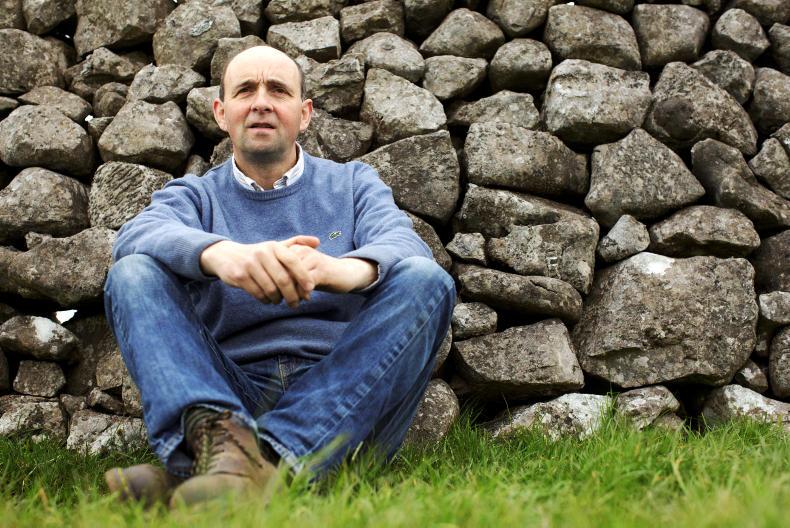
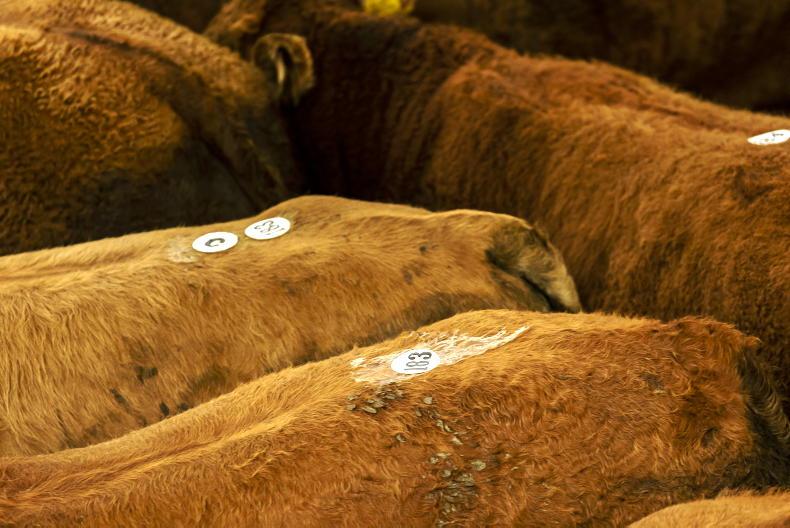

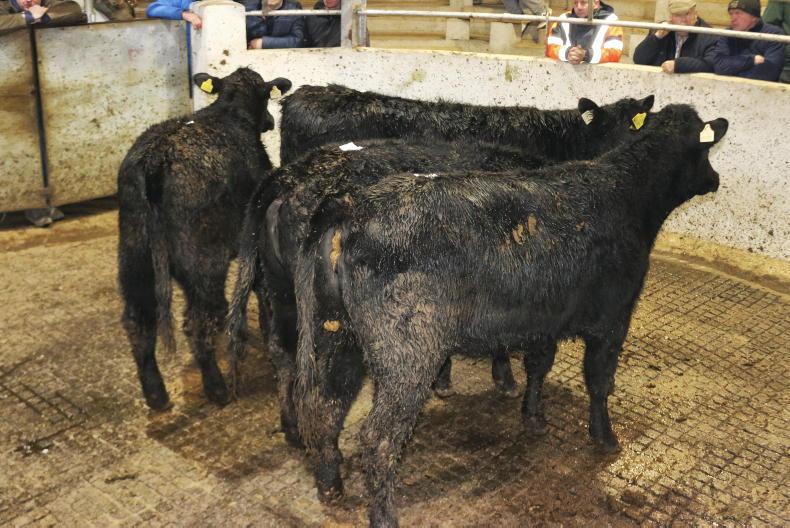


SHARING OPTIONS